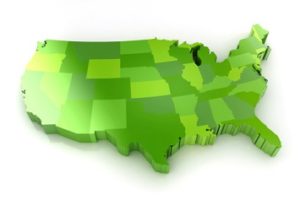Although the Trump administration has stated its intent and taken recent actions to reduce regulatory burdens for industry, environment, health, and safety (EHS) professionals cannot really breathe a sigh of relief because states are taking steps to make sure that they have the authority to develop and enforce environmental regulations no matter what happens on the federal level.
In the September meeting in Jackson Hole, Wyoming, the Environmental Council of States (ECOS), an organization of state and territorial environmental regulators, released a number of resolutions. Three of the resolutions are directly aimed at state independence from the U.S. Environmental Protection Agency’s (EPA) efforts to reduce regulations and enforcement. Let’s take a look at these three resolutions.
1. Use of Guidance
On its website concerning policy and guidance, the EPA claims that sometimes its authority to develop and enforce needs to be further explained, so it writes guidance documents. ECOS apparently now sees the need to ensure that the EPA maintains the stance that guidances not be enforced as regulations, are not legally binding, and should not be used as the legal basis for making a federal objection to a delegated state action.
To that end, the organization released a resolution, On the Use of Guidance. In the resolution, ECOS calls on the EPA, in part, to:
- Use guidance to provide states with direction for implementing federal laws but should not require compliance by states with guidance in the implementation of delegated programs and should not use guidance as the legal basis for objection to permits;
- Seek early, meaningful, and substantial involvement from states about the content of guidance and the practicalities of implementation; and
- Use guidance only to interpret its regulations rather than as a substitute for its regulation, as a change to its regulation, or as an expansion of its regulation.
2. Federal Rule Development
In another resolution concerning Federal Rule Promulgation and Implementation, ECOS seeks to ensure that the EPA maintains communication with states in developing and implementing new rules. To that end, ECOS encourages the EPA to:
- Better align compliance dates for rules that reduce the same or different pollutants from the same source sectors.
- Allow states to set standards that are more stringent or that are broader in scope than federal standards.
- Allow states the flexibility in implementing their programs to achieve national minimum standards.
- Involve states as partners early and often in developing federal environmental and public health policy.
- Publish its rules as final before seeking state adherence and implementation.
3. Leave California GHG Standards Alone
Under the Clean Air Act (CAA), California can develop its own vehicle emissions standards as long as they are at least as strict as the federal standards. Also under the CAA, other states can adopt the California standards if they so choose. Under this statutory scheme, California must request a waiver of preemption from federal standards, which it did and was granted for vehicle greenhouse gas (GHG) emissions in 2009.
With the Obama GHG emission reduction regulations now in the Trump administration’s crosshairs, ECOS wants to ensure that California—and therefore other states—still maintains the ability to implement and enforce stricter GHG vehicle emissions standards and, more broadly, standards to lower emissions of any pollutant.
In this resolution, ECOS calls on the federal government to allow states to exercise their discretion to regulate pollutants within their borders and develop standards at or stricter than federal regulations. The resolution specifically calls on Congress not to pass any laws that limit:
- Any state’s authority to adopt or enforce pollutant standards that are stricter than the federal regulations;
- California’s authority to adopt or enforce emissions standards for any air pollutant from any mobile source; and
- Any state’s ability under the CAA to adopt California’s vehicle emissions standards.
Takeaway for EHS Managers
As the federal government backs off the development and enforcement of environmental regulations that limit industry operations, your state and local government may be stepping in to take up the slack. These recent ECOS resolutions demonstrate that some states are not going “gently into that good night.” Make sure you know if your state is one that is raging against the dying of the environmental light.

